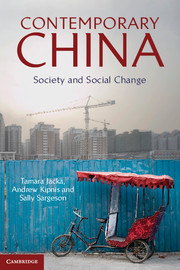Book contents
- Frontmatter
- Contents
- List of Images
- List of Maps
- List of Figures
- List of Tables
- Acknowledgments
- List of Abbreviations
- Map 0.1: China's provinces and provincial capitals
- Introduction
- Part 1 Social Institutions
- Part 2 Cultures, Socialization and the Formation of Identities
- Part 3 Inequalities, Injustices and Social Responses
- 10 Social Class and Stratification
- 11 Regional, Rural–Urban and Within-community Inequalities
- 12 The “Woman Question” and Gender Inequalities
- 13 Collective Action and Social Change
- Glossary of Chinese Terms
- References
- Index
11 - Regional, Rural–Urban and Within-community Inequalities
Published online by Cambridge University Press: 05 June 2014
- Frontmatter
- Contents
- List of Images
- List of Maps
- List of Figures
- List of Tables
- Acknowledgments
- List of Abbreviations
- Map 0.1: China's provinces and provincial capitals
- Introduction
- Part 1 Social Institutions
- Part 2 Cultures, Socialization and the Formation of Identities
- Part 3 Inequalities, Injustices and Social Responses
- 10 Social Class and Stratification
- 11 Regional, Rural–Urban and Within-community Inequalities
- 12 The “Woman Question” and Gender Inequalities
- 13 Collective Action and Social Change
- Glossary of Chinese Terms
- References
- Index
Summary
It is possible to use many different kinds of indicators to examine changes in regional, rural–urban and within-community inequalities in China. Cultural resources, such as control over knowledge and the ability to influence the values attached to various types of occupation in the public domain, can serve as indicators. In this chapter, though, we focus on material inequalities, including income, wealth and consumption.
Material inequalities are produced by multiple, interacting variables whose significance differs not only over time but also between locations. Much contemporary sociological research focuses on the social and discursive processes through which unequal identities and categories of person are produced, rather than on processes that distribute material resources, goods and services across geographical and economic space. However, the literature on China suggests that the greatest material inequalities are between groups of people defined and differentiated by spatial categorizations. The distribution of material inequalities across space matters for various reasons, not least of which is that people tend to be more tolerant of “inequality at a distance” than of inequality among neighbors. Insofar as growing inequality causes social tension, then, proximate inequality is most likely to produce that tension. Disentangling the spatial components of inequality may therefore better equip us to understand debates about the possible social impacts of changes in inequality.
- Type
- Chapter
- Information
- Contemporary ChinaSociety and Social Change, pp. 217 - 236Publisher: Cambridge University PressPrint publication year: 2013

